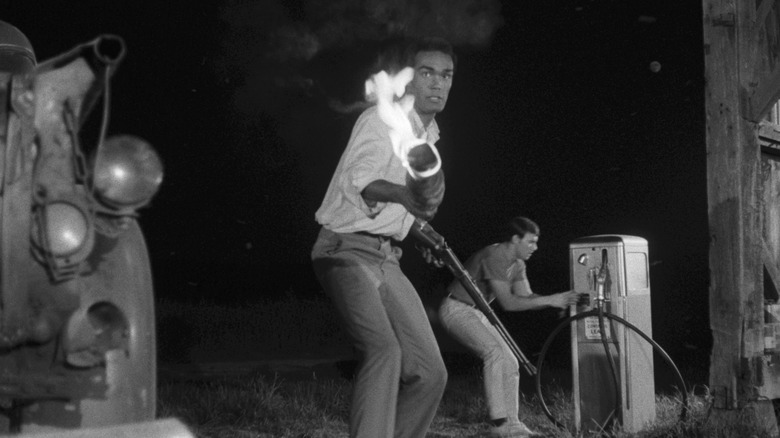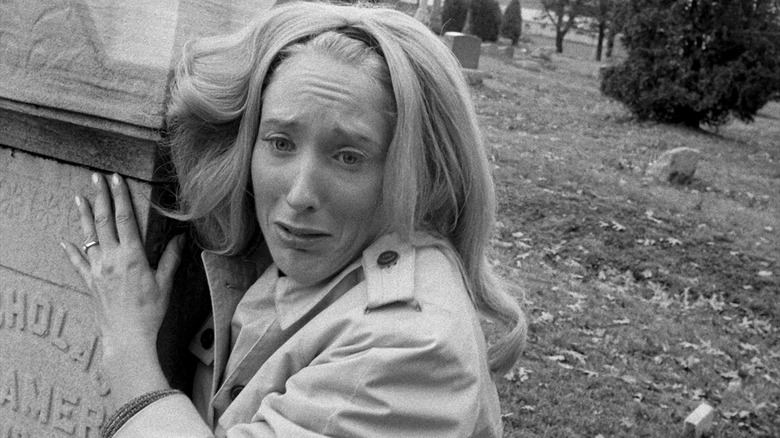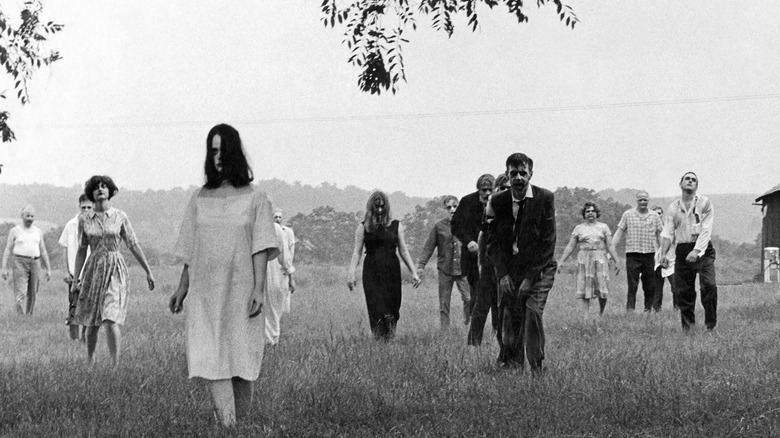George Romero Tried To Forget He Was Making Horror During Night Of The Living Dead
George Romero just happened to transition from making local TV commercials in Pittsburg to feature filmmaking during one of the most violent years in U.S. history. 1968 was rife with assassinations, protests, and riots that reshaped the political collective consciousness of America. Made for a mere $6,000 (about $50,000 today), "Night of the Living Dead" arrived in theaters in October, just months after Robert Kennedy's murder. The country was reeling and looked at Romero's original zombie classic with cynical eyes, reading deeply (maybe too deeply) into how the film reflected the splintered state of society at the time. The timely casting of Duane Jones in the lead role was also seen as a symbol of the civil rights movement.
For Romero and his main cast (consisting of Jones, Judith O'Dea, Karl Hardman, and Marilyn Eastman), "Night of the Living Dead" was just a chance to make "a real blood and guts film," according to the late director's comments in a recently unearthed 1972 interview with Filmmakers Newsletter Magazine. Referring to what became the modern illustration of the zombie as "ghouls," Romero didn't even want the actors to think of themselves as acting in a horror movie at all. Focusing on the quickly collapsing social dynamic inside the house proved to be scarier than what was lurking outside.
How to act with zombies: A beginner's guide
In the original short story written by Romero, "Night of the Living Dead" was more of an "allegorical thing" (I can almost hear his lovely Pittsburghese accent) when he first dreamed up the idea. In the 1972 interview, Romero revealed that the story was "written to draw a parallel between what people are becoming and the idea that people are operating on many levels of insanity that are only clear to themselves." In actuality, "Living Dead" became much more straightforward and matter-of-fact. "We shot it just the way things would be if the dead returned to life," said Romero. "For instance, we let the news commentator write his own copy."
One of Romero's main issues was trying to get the actors to look at the undead uprising as something that could actually happen. When asked what some of his problems were as a director, he didn't hesitate (via Variety):
"Primarily to forget that we were making a horror film. I just wanted them to appear as though they were worried about a snowstorm or something. I didn't want anybody to get very intense with it except in the areas where we just threw up our hands and went camp with it and then we just had fun."
Romero continued to describe how he worked with the cast to essentially trick them into feeling more comfortable:
"A lot of the time I'd create the situation and get them moving before I'd even pick up the camera. Like in the sieges and some of the bigger scenes, I'd just get the situation going and walk around and look at it for awhile, then I'd pick up the camera and start shooting."
They're coming for you George
At the time of this interview, the now internationally revered director isn't quite aware yet of the massive cultural impact he's made. He was just a filmmaker who got lucky with "Night of the Living Dead." Looking forward to his iconic films like the mall masterpiece "Dawn of the Dead," the horror anthology staple "Creepshow," or his coming-of-age vampire tale "Martin," it's much easier for us to see Romero as the true auteur that he is.
"Night of the Living Dead" became a somewhat reluctant representative of the sweeping change that was happening across America with the counter-culture movement. It eventually solidified Romero as the "father of the modern movie zombie," as declared in his obituary. Now that Romero has a star on the Hollywood Walk of Fame and a golden statue inside the Monroeville Mall outside Pittsburgh where "Dawn" was filmed (a monument I have posed with for a teary-eyed snapshot), the lasting legacy of George A. Romero should be firmly intact. Moviegoing audiences will continue to discover and reexamine his filmography for decades to come. (And I'm sure he'd even be okay with audiences placing a little extra meaning behind the work.) Revisit "Night of the Living Dead" this Halloween season and always remember George's favorite advice when signing autographs for his fans: "Stay scared."


